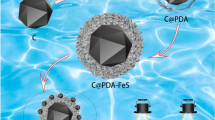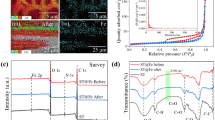Abstract
The pollutants degradation rate of iron ore tailings–based heterogeneous catalysts is the main factor limiting its application. Herein, an iron ore tailings–based Fenton-like catalyst (I/W(3:1)-900-60) with a relatively fast catalysis rate was constructed by co-pyrolysis (900°C, 60 min holding time) of iron ore tailings and wheat straw with a mass ratio of 3:1. With wheat straw blending, the generated I/W(3:1)-900-60 presented a larger surface area (24.53 m2/g), smaller pore size (3.76 nm), reduced iron species (Fe2+ from magnetic), and a higher catalytic activity (0.0229 min−1) than I-900-60 (1.32 m2/g, 12.87 nm, 0.012 min−1) pyrolyzed using single iron ore tailing under the same pyrolysis conditions. In addition, biochar and iron ore tailings in I/W(3:1)-900-60 were tightly combined through chemical bonding. The optimal catalyst remains active after three cycles, indicating its catalytic stability and recyclability. The good Fenton-like methylene blue degradation efficiency of I/W(3:1)-900-60 was ascribed to the sacrificial role of biochar, as well as the electron transfer between biochar and iron active sites or the redox cycles of ≡Fe3+/Fe2+. This finding provides a facile construction strategy for highly active iron ore tailings–based Fenton-like catalyst and thereby had a great potential application in wastewater treatment.






Similar content being viewed by others
Availability of data and materials
All data generated or analyzed during this study are included in this published article.
Change history
25 April 2022
A Correction to this paper has been published: https://doi.org/10.1007/s11356-022-20374-z
References
Augusto TDM, Chagas P, Sangiorge DL, Mac Leod TCDO, Oliveira LCA, De Castro CS (2018) Iron ore tailings as catalysts for oxidation of the drug paracetamol and dyes by heterogeneous Fenton. J Environ Chem Eng 6:6545–6553. https://doi.org/10.1016/j.jece.2018.09.052
Batista ÉR, Carneiro JJ, Araújo Pinto F, dos Santos JV, Carneiro MAC (2020) Environmental drivers of shifts on microbial traits in sites disturbed by a large-scale tailing dam collapse. Sci Total Environ 738:1–12. https://doi.org/10.1016/j.scitotenv.2020.139453
Costa RCC, Moura FCC, Ardisson JD, Fabris JD, Lago RM (2008) Highly active heterogeneous Fenton-like systems based on Fe0/Fe3O4 composites prepared by controlled reduction of iron oxides. Appl Catal B Environ 83:131–139
de Freitas VAA, Breder SM, Silvas FPC, Radino Rouse P, de Oliveira LCA (2019) Use of iron ore tailing from tailing dam as catalyst in a Fenton-like process for methylene blue oxidation in continuous flow mode. Chemosphere 219:328–334. https://doi.org/10.1016/j.chemosphere.2018.12.052
Ding C, Zeng Y, Cao L, Zhao L, Zhang Y (2016) Hierarchically porous Fe3O4/C nanocomposite microspheres via a CO2 bubble-templated hydrothermal approach as high-rate and high-capacity anode materials for lithium-ion batteries. J Mater Chem A 4:5898–5908
Doelsch E, Masion A, Rose J, Stone WEE, Bottero JY, Bertsch PM (2003) Chemistry and structure of colloids obtained by hydrolysis of Fe(III) in the presence of SiO4 ligands. Colloids Surf A Physicochem Eng Asp 217:121–128. https://doi.org/10.1016/S0927-7757(02)00566-6
dos Santos PL, Guimarães IR, Mesquita AM, Guerreiro MC (2016) Copper-doped akaganeite: application in catalytic Cupro-Fenton reactions for oxidation of methylene blue. J Mol Catal A Chem 424:194–202. https://doi.org/10.1016/j.molcata.2016.08.034
Duarte F, Maldonado-Hódar FJ, Madeira LM (2012) Influence of the particle size of activated carbons on their performance as Fe supports for developing Fenton-like catalysts. Ind Eng Chem Res 51:9218–9226. https://doi.org/10.1021/ie300167r
Ellison CR, Boldor D (2021) Mild upgrading of biomass pyrolysis vapors via ex-situ catalytic pyrolysis over an iron-montmorillonite catalyst. Fuel 291:120226. https://doi.org/10.1016/j.fuel.2021.120226
Fang G, Gao J, Dionysiou DD, Liu C, Zhou D (2013) Activation of persulfate by quinones: free radical reactions and implication for the degradation of PCBs. Environ Sci Technol 47:4605–4611. https://doi.org/10.1021/es400262n
Fang G, Gao J, Liu C, Dionysiou DD, Wang Y, Zhou D (2014) Key role of persistent free radicals in hydrogen peroxide activation by biochar: implications to organic contaminant degradation. Environ Sci Technol 48:1902–1910. https://doi.org/10.1021/es4048126
Gao L, Goldfarb JL (2019) Solid waste to biofuels and heterogeneous sorbents via pyrolysis of wheat straw in the presence of fly ash as an in situ catalyst. J Anal Appl Pyrolysis 137:96–105. https://doi.org/10.1016/j.jaap.2018.11.014
Gao C, Chen S, Quan X, Yu H, Zhang Y (2017) Enhanced Fenton-like catalysis by iron-based metal organic frameworks for degradation of organic pollutants. J Catal 356:125–132. https://doi.org/10.1016/j.jcat.2017.09.015
Gong X, Guo Z, Wang Z (2012) Effects of Fe2O3 on pyrolysis reactivity of demineralized higher rank coal and its char structure. Ciesc J 60:2321–2326. https://doi.org/10.16552/j.cnki.issn1001-1625.2016.06.035
Gou Y, Chen P, Yang L, Li S, Peng L, Song S, Xu Y (2021) Degradation of fluoroquinolones in homogeneous and heterogeneous photo-Fenton processes: a review. Chemosphere 270:1–12. https://doi.org/10.1016/j.chemosphere.2020.129481
He Q, Dai J, Zhu L, Xiao K, Yin Y (2016) Synthesis and lead absorption properties of sintered activated carbon supported zero-valent iron nanoparticle. J Alloys Compd 687:326–333. https://doi.org/10.1016/j.jallcom.2016.06.139
Hu X, Liu B, Deng Y, Chen H, Luo S, Sun C, Yang P, Yang S (2011) Adsorption and heterogeneous Fenton degradation of 17α-methyltestosterone on nano Fe3O4/MWCNTs in aqueous solution. Appl Catal B Environ 107:274–283. https://doi.org/10.1016/j.apcatb.2011.07.025
Hua Y, Wang S, Xiao J, Cui C, Wang C (2017) Preparation and characterization of Fe3O4/gallic acid/graphene oxide magnetic nanocomposites as highly efficient Fenton catalysts. RSC Adv 7:28979–28986
Huang D, Yan Q, Xue X, Ren Y, Shen Y (2020) Preparation of iron tailings-based porous substrate and its application in synthesis of Co3O4 nanowires. Conserv Util Miner Resour 40:64–68
Khachatryan L, Dellinger B (2011) Environmentally persistent free radicals (EPFRs)-2. Are free hydroxyl radicals generated in aqueous solutions? Environ Sci Technol 45:9232–9239. https://doi.org/10.1021/es201702q
Kossoff D, Dubbin WE, Alfredsson M, Edwards SJ, Macklin MG, Hudson-Edwards KA (2014) Mine tailings dams: characteristics, failure, environmental impacts, and remediation. Appl Geochem 51:229–245. https://doi.org/10.1016/j.apgeochem.2014.09.010
Kwan WP, Voelker BM (2002) Decomposition of hydrogen peroxide and organic compounds in the presence of dissolved iron and ferrihydrite. Environ Sci Technol 36:1467–1476. https://doi.org/10.1021/es011109p
Li K, Zhao Y, Song C, Guo X (2017a) Magnetic ordered mesoporous Fe3O4/CeO2 composites with synergy of adsorption and Fenton catalysis. Appl Surf Sci 425:526–534
Li S, Gao L, Wen H, Li G, Wang Y (2017b) Modification and application of coking coal by alkali pretreatment in wastewater adsorption. Sep Sci Technol 52:2532–2539. https://doi.org/10.1080/01496395.2017.1355383
Li W, Wu X, Li S, Tang W, Chen Y (2018) Magnetic porous Fe3O4/carbon octahedra derived from iron-based metal-organic framework as heterogeneous Fenton-like catalyst. Appl Surf Sci 436:252–262. https://doi.org/10.1016/j.apsusc.2017.11.151
Li D, Yang T, Li Y, Liu Z, Jiao W (2020) Facile and green synthesis of highly dispersed tar-based heterogeneous Fenton catalytic nanoparticles for the degradation of methylene blue. J Clean Prod 246:1–11
Liu W, Qian J, Wang K, Xu H, Jiang D, Liu Q, Yang X, Li H (2013) Magnetically separable Fe3O4 nanoparticles-decorated reduced graphene oxide nanocomposite for catalytic wet hydrogen peroxide oxidation. J Inorg Organomet Polym Mater 23:907–916. https://doi.org/10.1007/s10904-013-9863-4
Luo W, Zhu L, Wang N, Tang H, Cao M, She Y (2010) Efficient removal of organic pollutants with magnetic nanoscaled BiFeO3 as a reusable heterogeneous Fenton-like catalyst. Environ Sci Technol 44:1786–1791. https://doi.org/10.1021/es903390g
Neamţu M, Zaharia C, Catrinescu C, Yediler A, Macoveanu M, Kettrup A (2004) Fe-exchanged Y zeolite as catalyst for wet peroxide oxidation of reactive azo dye Procion Marine H-EXL. Appl Catal B Environ 48:287–294. https://doi.org/10.1016/j.apcatb.2003.11.005
Pang Y, Xu Y, Chen Y, Shen S, Yin W, Wang X (2019) Experimental study on catalytic pyrolysis of pine sawdust added with Fe2O3. J Therm Sci Technol 18:185–190
Park HS, Koduru JR, Choo KH, Lee B (2015) Activated carbons impregnated with iron oxide nanoparticles for enhanced removal of bisphenol A and natural organic matter. J Hazard Mater 286:315–324. https://doi.org/10.1016/j.jhazmat.2014.11.012
Ren B, Miao J, Xu Y, Zhai Z, Dong X, Wang S, Zhang L, Liu Z (2019) A grape-like N-doped carbon/CuO-Fe2O3 nanocomposite as a highly active heterogeneous Fenton-like catalyst in methylene blue degradation. J Clean Prod 240:1–10
Rico M, Benito G, Salgueiro AR, Díez-Herrero A, Pereira HG (2008) Reported tailings dam failures. A review of the European incidents in the worldwide context. J Hazard Mater 152:846–852. https://doi.org/10.1016/j.jhazmat.2007.07.050
Saleh TA, Naeemullah, Tuzen M, Sarı A (2017) Polyethylenimine modified activated carbon as novel magnetic adsorbent for the removal of uranium from aqueous solution. Chem Eng Res Des 117:218–227. https://doi.org/10.1016/j.cherd.2016.10.030
Sharma A, Pareek V, Zhang D (2015) Biomass pyrolysis – a review of modelling, process parameters and catalytic studies. Renew Sust Energ Rev 50:1081–1096. https://doi.org/10.1016/j.rser.2015.04.193
Silva AC, Cepera RM, Pereira MC, Lima DQ, Fabris JD, Oliveira LCA (2011) Heterogeneous catalyst based on peroxo-niobium complexes immobilized over iron oxide for organic oxidation in water. Appl Catal B Environ 107:237–244. https://doi.org/10.1016/j.apcatb.2011.07.017
Wang D, Xiao R, Zhang H, He G (2010) Comparison of catalytic pyrolysis of biomass with MCM-41 and CaO catalysts by using TGA-FTIR analysis. J Anal Appl Pyrolysis 89:171–177. https://doi.org/10.1016/j.jaap.2010.07.008
Wang Q, Tian S, Ning P (2014) Degradation mechanism of methylene blue in a heterogeneous Fenton-like reaction catalyzed by Ferrocenc. Ind Eng Chem Res 53:643–649
Wang X, Zhao H, Li Y, Song Q, Shu X (2018) Study on releasing characteristics of pyrolysis gas products and kinetic analysis of lignite pyrolysis at different heating rates based on TG-MS. Coal Eng 50:140–144
Williams P, Besler S (1996) The influence of temperature and heating rate on the slow pyrolysis of biomass. Renew Energy 7:233–250
Xun T, Jianan Z, Xuekai J, Bao W (2019) Catalysis of Fe2O3 for coal char pyrolysis. J Wuhan Univ Sci Technol Univ Sci Technol 42:117–120
Yang XJ, Xu XM, Xu J, Han YF (2013) Iron oxychloride (FeOCl): an efficient Fenton-like catalyst for producing hydroxyl radicals in degradation of organic contaminants. J Am Chem Soc 135:16058–16061. https://doi.org/10.1021/ja409130c
Yang J, Pan B, Li H, Liao S, Zhang D, Wu M, Xing B (2016) Degradation of p-Nitrophenol on biochars: role of persistent free radicals. Environ Sci Technol 50:694–700. https://doi.org/10.1021/acs.est.5b04042
Yi L, Mi H, Wu Q, Xia J, Zhang B (2020) Present situation of comprehensive utilization of tailings resources in China. Conserv Util Miner Resour 3:814–815. https://doi.org/10.1038/163814b0
Yuan SJ, Dai XH (2014) Facile synthesis of sewage sludge-derived mesoporous material as an efficient and stable heterogeneous catalyst for photo-Fenton reaction. Appl Catal B Environ 154–155:252–258. https://doi.org/10.1016/j.apcatb.2014.02.031
Zhang H, Xue G, Chen H, Li X (2018) Magnetic biochar catalyst derived from biological sludge and ferric sludge using hydrothermal carbonization: preparation, characterization and its circulation in Fenton process for dyeing wastewater treatment. Chemosphere 191:64–71. https://doi.org/10.1016/j.chemosphere.2017.10.026
Zheng J, Gao Z, He H, Yang S, Sun C (2016) Efficient degradation of acid orange 7 in aqueous solution by iron ore tailing Fenton-like process. Chemosphere 150:40–48. https://doi.org/10.1016/j.chemosphere.2016.02.001
Zhu S, Huang X, Ma F, Wang L, Duan X, Wang S (2018) Catalytic removal of aqueous contaminants on N-doped graphitic biochars: inherent roles of adsorption and nonradical mechanisms. Environ Sci Technol 52:8649–8658. https://doi.org/10.1021/acs.est.8b01817
Acknowledgements
The authors wish to express their regards to Ms. Jing Hou for her assistance during the COD measuring experiments.
Funding
L.Gao acknowledges the financial support of the National Natural Science Foundation of China (5210040121), the Jiangsu Provincial Natural Science Foundation of China (BK20210498), and the fellowship of China Postdoctoral Science Foundation (2021M693420).
Author information
Authors and Affiliations
Contributions
Lihui Gao: writing – original draft, methodology, data curation; Lizhang Wang: writing – reviewing and editing; Shulei Li: investigation, sample preparation; Yijun Cao: supervision and editing.
Corresponding authors
Ethics declarations
Ethics approval and consent to participate
Not applicable
Consent for publication
Not applicable
Competing interests
The authors declare no competing interests.
Additional information
Responsible Editor: Ricardo A. Torres-Palma
Publisher’s note
Springer Nature remains neutral with regard to jurisdictional claims in published maps and institutional affiliations.
The original online version of this article was revised: The published paper is the uncorrected proof.
Supplementary Information
ESM 1
(DOCX 612 KB)
Rights and permissions
About this article
Cite this article
Gao, L., Wang, L., Li, S. et al. Highly active Fenton-like catalyst derived from solid waste-iron ore tailings using wheat straw pyrolysis. Environ Sci Pollut Res 29, 31567–31576 (2022). https://doi.org/10.1007/s11356-021-17168-0
Received:
Accepted:
Published:
Issue Date:
DOI: https://doi.org/10.1007/s11356-021-17168-0




